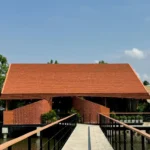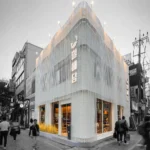In today’s world, where environmental concerns are at the forefront, sustainable architecture has emerged as a vital practice. One of the most crucial elements of this movement is the facade. It’s not just about aesthetics; facades play a significant role in energy efficiency and resource management.
By integrating innovative materials and design techniques, we can create facades that not only enhance a building’s visual appeal but also contribute to its sustainability. From passive solar design to green walls, the possibilities are endless. Join us as we explore how facades can transform our approach to sustainable architecture and pave the way for a greener future.

Overview of Facade in Sustainable Architecture
Facades play a critical role in sustainable architecture by combining aesthetic appeal with environmental performance. Facades influence energy efficiency by regulating temperature, light, and airflow, ultimately reducing reliance on mechanical heating and cooling systems.
Facades utilizing innovative materials enhance insulation and minimize energy consumption. For instance, materials like high-performance glazing or insulated metal panels improve thermal performance while allowing natural light to penetrate interiors.
Passive solar design is another key approach in facade design. We can orient facades to capture sunlight effectively, using overhangs and shading devices to control solar gain during different seasons. Such strategies reduce energy influx in warmer months and retain heat during colder months.
Green walls contribute to reducing urban heat islands and improving air quality. These living systems absorb CO2 and promote biodiversity, making urban environments more sustainable. Additionally, they provide natural insulation, further enhancing energy efficiency.
Incorporating renewable energy technologies into facades also promotes sustainability. Building-integrated photovoltaics (BIPV) generate electricity while maintaining visual appeal. By offsetting energy consumption, these technologies align with our goals for a sustainable future.
Through thoughtful design and material choices, facades become integral components of sustainable architecture. They not only contribute to a building’s environmental performance but also reflect our commitment to a sustainable architectural framework.
Importance of Facades in Sustainability
Facades play a crucial role in sustainable architecture by merging functionality with aesthetic sensibility. Their design significantly impacts energy efficiency and visual appeal.

Energy Efficiency
Facades enhance energy efficiency by regulating temperature and airflow. They minimize reliance on mechanical heating and cooling systems, leading to lower energy consumption. Utilizing innovative materials like high-performance glazing and insulated metal panels improves thermal performance while allowing for natural light entry. Passive solar design techniques orient facades to maximize sunlight capture, reducing energy costs. Shading devices and overhangs control solar gain, providing comfort without excessive energy use.
Through these measures, facades contribute to significant energy savings, thus playing an essential part in sustainable practices.
Aesthetic Appeal
Facades also contribute aesthetic appeal to buildings, reflecting the character of the surrounding environment. They combine creative design elements with sustainability goals. For instance, integrating green walls not only beautifies urban spaces but also helps reduce heat islands and improve air quality.
Sustainable facades often incorporate local materials, further enriching the building’s connection to its locale. Engaging aesthetics encourage community interaction and support local culture, enhancing overall well-being. This dual focus on beauty and sustainability reinforces the significance of facades in contemporary architecture.
Types of Sustainable Facades
Sustainable facades come in various forms, each contributing uniquely to energy efficiency and environmental responsibility. We focus on two prominent types: green facades and double-skin facades.

Green Facades
Green facades integrate vegetation into building exteriors, enhancing aesthetics while promoting sustainability. We utilize climbing plants or vertical gardens to create living walls, which improve air quality and reduce the urban heat island effect. Green facades offer natural insulation, helping to stabilize indoor temperatures and lower energy consumption. These facades also support biodiversity by providing habitats for various species. By choosing native plants, we foster a connection with the local environment and reduce maintenance needs.
Double-Skin Facades
Double-skin facades consist of two layers of glazing, creating a ventilated air gap between them. This design improves thermal performance by reducing heat transfer, thus saving energy. We can control airflow within the cavity, allowing natural ventilation and regulating indoor temperatures. This feature decreases the reliance on mechanical heating and cooling systems. Double-skin facades also enhance acoustic performance, dampening noise from the outside and providing a comfortable indoor environment. Moreover, they facilitate the use of solar heat gain, optimizing energy use throughout the seasons.
By leveraging these types of sustainable facades, we can create buildings that align with ecological goals while maintaining functional and aesthetic qualities.
Materials Used in Sustainable Facades
Sustainable facades utilize a variety of materials that contribute to energy efficiency, environmental conservation, and aesthetic appeal. By choosing the right materials, we enhance the effectiveness of our building designs while minimizing ecological impact.

Recycled Materials
Recycled materials offer significant benefits for sustainable facades. We often use reclaimed wood, recycled metals, and repurposed glass. These materials not only reduce waste but also decrease the demand for new resources. For instance, using reclaimed wood decreases deforestation and preserves existing ecosystems. Recycled aluminum and steel, sourced from consumer products, lower energy consumption in manufacturing, as recycling these metals uses 95% less energy than producing them from raw materials. Incorporating these recycled elements not only enhances the sustainability of our buildings but also adds unique character to their facades.
Biodegradable Options
Biodegradable materials present an innovative approach to sustainable facades. We might opt for materials like bamboo, straw bales, or rammed earth. Bamboo grows rapidly and absorbs significant amounts of carbon dioxide, making it a carbon-positive option. Straw bales provide excellent insulation and can decompose naturally at the end of their lifecycle, returning nutrients to the earth. Rammed earth, constructed with compacted soil, exhibits durability and thermal mass properties while reducing reliance on synthetic materials. Using biodegradable options ensures that our architectural designs align with ecological principles, promoting a more sustainable built environment.
Innovations in Façade Technology
Innovations in facade technology play a vital role in the evolution of sustainable architecture. Smart and adaptive facades emerge as key solutions that enhance energy efficiency, user comfort, and aesthetic appeal.

Smart Facades
Smart facades integrate technology to respond dynamically to environmental conditions. These facades utilize sensors and automated systems to optimize light, temperature, and airflow. For example, electrochromic glazing changes its tint based on sunlight intensity, reducing glare while maintaining natural light. Additionally, automated shading systems can retract or extend depending on solar angles, minimizing heat gain in summer while maximizing warmth in winter. Smart materials, such as phase-change materials, store and release thermal energy, facilitating temperature regulation. These features lead to significant energy savings and increased occupant comfort in buildings.
Adaptive Facades
Adaptive facades feature systems that change in response to varying environmental factors. This adaptability allows for improved thermal performance and user experience. For example, operable windows or vents enable natural ventilation, reducing reliance on HVAC systems. Additionally, dynamic shading devices adjust throughout the day to optimize daylight while minimizing solar heat gain. Some adaptive facades even employ bioreceptive materials that support plant growth, enhancing building insulation while contributing to local biodiversity. These elements transform facades into living systems, allowing buildings to respond efficiently to their surroundings and user needs.
Through the integration of smart and adaptive technologies, sustainable facades increasingly enhance the performance and resilience of architecture, merging functionality with environmental stewardship.
Conclusion
Facades play a critical role in sustainable architecture by balancing aesthetics, energy efficiency, and resource management. We see that through innovative materials and design techniques, facades can enhance both the visual appeal and sustainability of buildings. Incorporating features like passive solar design and green walls helps us regulate temperature, light, and airflow, significantly reducing reliance on mechanical systems.
We recognize the importance of high-performance glazing and insulated metal panels in improving thermal performance while allowing natural light entry. The strategic orientation of facades and the use of shading devices enable effective solar gain control. Furthermore, green walls offer additional benefits such as reducing urban heat islands, enhancing air quality, and providing natural insulation for spaces.
Sustainable facades reflect local character and foster community engagement by utilizing local materials. We also appreciate the integration of renewable energy technologies, such as building-integrated photovoltaics (BIPV), which generate electricity without compromising aesthetic quality.
Specific types of facades, like green and double-skin facades, contribute to our ecological goals. Green facades, with their integration of vegetation, support biodiversity and improve air quality. Double-skin facades provide enhanced thermal performance and natural ventilation, embodying functionality and beauty.
Innovations in facade technology, particularly smart and adaptive systems, provide further advancements in energy efficiency and user comfort. Smart facades equipped with sensors and automation optimize light and airflow, while adaptive facades respond dynamically to environmental changes, enhancing the overall user experience.
We assert that thoughtful design and material selections, along with the integration of smart technologies, solidify facades as essential elements of sustainable architecture, committing to a more environmentally responsible future while promoting overall well-being.
- advanced building envelopes
- Architectural Innovation
- building envelope technology
- climate responsive facades
- dynamic building facades
- Eco-friendly architecture
- energy efficient building facades
- environmentally friendly construction
- Facade Design
- green building facade
- high performance building design
- innovative facade solutions
- low energy architecture
- passive solar design
- smart facade technology
- solar shading systems
- Sustainable Architecture
- sustainable building materials
- sustainable facade systems
- ventilated facade systems
















Leave a comment